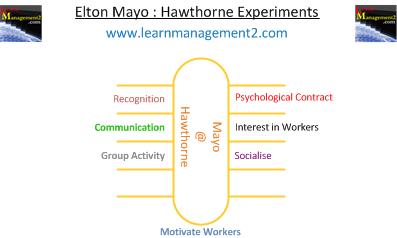|
|
|
LEARN MANAGEMENT2 .com |
Home | Business Management Concepts | About LearnManagement2 Business Presentations | Business Management Clip Arts| LearnManagement Blog HOME OF BUSINESS MANAGEMENT THEORY AND CONCEPTS For Business Management Learners Across The Globe |
HAWTHORNE EXPERIMENTS
ELTON MAYORelated Links: Herzberg | Scientific Management | Likert | Victor Vroom | John Adair |
Introduction
Elton Mayo’s team conducted a number of experiments involving six female workers. These experiments are often referred to as the Hawthorne experiments or Hawthorne studies as they took place at The Hawthorne Works of the Western Electric Company in Chicago.
Hawthorne Experiment Details
Over the course of five years, Mayo’s team altered the female worker’s working conditions and monitored how the change in working conditions affected the workers morale and productivity. The changes in working conditions included changes in working hours, rest brakes, lighting, humidity, and temperature. The changes were explained to the workers prior to implementation.
Hawthorne Experiment Results
At the end of the five year period, the female worker’s working conditions, reverted back to the conditions before the experiment began. Unexpectedly the workers morale and productivity rose to levels higher than before and during the experiments. The combination of results during and after the experiment (ie the increase in the workers productivity when they were returned to their original working conditions) led Mayo to conclude that workers were motivated by psychological conditions more than physical working condition.
Hawthorne Experiment Conclusions
After analysing the results from the Hawthorne experiments Mayo concluded that workers were motivated by more than self interest and the following had an impact too:
Psychological Contract
There is an unwritten understanding between the worker and employer regarding what is expected from them; Mayo called this the psychological contract.Interest in Workers
A worker’s motivation can be increased by showing an interest in them. Mayo classified studying the workers (through the experiments) as showing an interest in the workers.Work is a Group Activity
Work is a group activity, team work can increase a worker’s motivation as it allows people to form strong working relationships and increases trust between the workers. Work groups are created formally by the employer but also occur informally. Both informal and formal groups should be used to increase productivity as informal groups influence the worker’s habits and attitudes.Social Aspect of Work
Workers are motivated by the social aspect of work, as demonstrated by the female workers socialising during and outside work and the subsequent increase in motivation.Recognise Workers
Workers are motivated by recognition, security and a sense of belonging.Communication
The communication between workers and management influences workers’ morale and productivity. Workers are motivated through a good working relationship with management.Conclusion
The traditional view of how to motivate employees is that you offer monetary rewards (pay increases, bonuses etc) for work completion. However the Hawthorne experiments may suggest that motivation is more complicated than that. Advocates of the "Hawthorne Effect" will state that the Hawthorne experiment results show that motivation can be improved through improving working relationships and social interraction.
|

